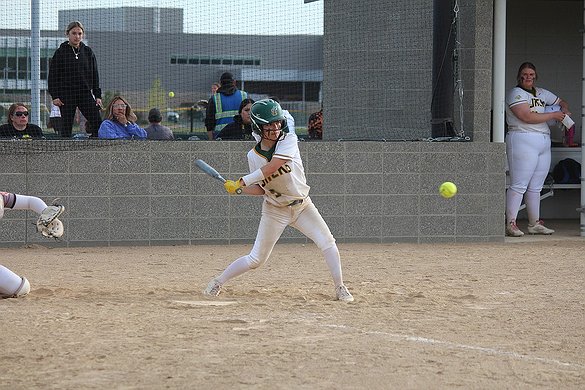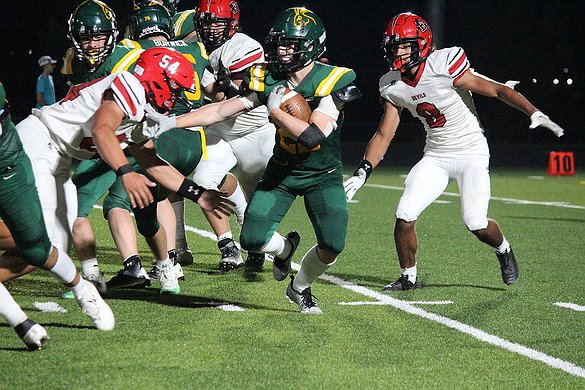'Quincy has always bounced back and forth'
Ian Bivona serves as the Columbia Basin Herald’s sports reporter and is a graduate of Auburn University in Auburn, Alabama. He enjoys the behind-the-scenes stories that lead up to the wins and losses of the various sports teams in the Basin. Football is his favorite sport, though he likes them all, and his favorite team is the Jets. He lives in Soap Lake with his cat, Honey. | August 12, 2024 3:00 AM
QUINCY — Sixty-three high schools across the state will compete in the 2A classification of the Washington Interscholastic Activities Association once the school year begins this fall. One of those schools will be the Quincy Jackrabbits, who spent the last four years in the 1A classification.
“Quincy has always bounced back and forth,” Quincy Athletic Director Brett Fancher said. “It’s kind of been on that 1A, 2A line.”
Moving classifications is nothing new to the Jackrabbits’ athletic programs; Quincy was in the 2A Central Washington Athletic Conference two classification cycles ago.
The school has jumped between the 1A and 2A classifications often; the longest period the Jacks stayed in one classification was their stint in 1A from the mid-1970s to the late ’90s, Fancher said.
“There was a good 20-year run — a lot of the parents and grandparents that are in town now remember that time, and that was a 10-school league that included schools all the way in the Okanogan and Lake Roosevelt,” Fancher said.
The previous classification cycle used the percentage of students on free- and reduced-lunch plans as a factor in determining the adjusted number of average enrolled students. There were some issues with that, and the WIAA found a different way to calculate that percentage for the 2024-28 classification cycle.
“It was just not an accurate representation; we were not able to get good data from that date source,” Fancher said.
Direct Cert replaced the free- and reduced-lunch percentage previously used in adjusting the average enrollment in WIAA member schools. The new process tracks free- and reduced-lunch numbers and other economic criteria through a Local Education Agency, according to the Office of Superintendent of Public Instruction.
“It’s the ratio of students in your school that qualify for one federal program or another,” Fancher explained. “That is just a little bit different than free and reduced lunch, so that change kind of skewed Quincy just enough to be back in the 2A.”
According to the WIAA, Quincy’s average enrollment of grades 9-11 for the 2024-2028 classification cycle is 696.88; with the adjusted enrollment from the Direct Cert percentage, that number drops to 501.75. For comparison, Quincy’s average enrollment for the 2020-2024 classification cycle was 599 students and adjusted to 419.3 with the free-and-reduced lunch percentage.
Classifications are based on the number of students in the adjusted enrollment; 1-104 students are in 1B, 105-225 are in 2B, 225-449 are in 1A, 450-899 are in 2A, 900-1,200 are in 3A and 1,201-plus are in 4A. There are exceptions; teams can opt up for higher classifications, appeal their decision to the WIAA or petition down a classification in football only.
Fancher said that while QHS had nearly 900 students enrolled at the end of the 2023-24 school year, the number of students that turned out for athletic programs was more in line with schools in the 1A classification. The focus on bringing more students into athletics is something the athletic department is ongoing.
“We’ve seen growth there, but we aren’t on the same level (in) pool of athletes that the other schools in the CWAC were at,” he said.
The WIAA released their adjusted enrollments in December, and with Quincy’s numbers, it appeared that the Jacks would move up to 2A.
Quincy went through two rounds of appeals once classification changes were released in January; the first was paperwork and a Zoom meeting at the district directors' level, while the second was an in-person hearing in front of the WIAA’s executive board in Renton attended by Fancher, boys basketball Head Coach Scott Bierlink and Quincy School District Superintendent Nik Bergman.
“One thing we were really hoping to communicate to the WIAA is we just want some stability,” Fancher said. “We seem to have a good fit opponent-wise, competitive-wise with the other schools in the Caribou Trail League. We had an energy and buzz playing those schools, because we have some historical connections there. The benefit of those league affiliations on our school was measurable.”
Bierlink said another focus of the appeal was the lack of QHS students that take part in non-school-affiliated athletics, like club or travel teams.
“We’ve got a bunch of free-and-reduced lunch kids, and that takes away most of their ability to go do a club team, to go to a travel team,” Bierlink said. “There’s a pretty steep expense with some of those, and most of our kids don’t have that opportunity.”
Both of Quincy’s rounds of appeals were denied, leaving the Jacks to move back into the CWAC.
“We kind of had a feeling that it wasn’t going to go our way, but we gave it our best shot,” Bierlink said. “Obviously, it didn't work out.”
One of the most significant changes in moving from the CTL to the CWAC is the size of the league; the former CTL included Quincy, Cashmere, Chelan, Cascade (Leavenworth) and Omak. The new CWAC includes Ephrata, Othello, Ellensburg, East Valley (Yakima), Grandview, Prosser, Selah, Toppenish and Quincy.
While traveling to Omak was a long trip for Quincy’s athletic teams, they only had to make that long of a trip to play against the Pioneers. Those long trips will come more frequently over the next four years when it comes to road games against Prosser, Grandview and Toppenish.
“We have a greater frequency of those long trips,” Fancher said. “That means time out of school, that means more strain on our transportation department with getting those trips covered. Some of these things, we’re going to have to be more flexible.”
Playing in a bigger league means more league games, and that means fewer non-league games.
“Obviously you want to win every game, but (non-league losses) doesn’t affect your league standings,” Bierlink said. “You can try out rotations, you can try kids out at different positions and get a feel for what you have for a team that year. Going in the CWAC, I think we have four non-league games. It does make it kind of tough.”
Fewer non-league games on the schedule also make it more difficult to maintain historic rivalries against teams in the CTL, though Fancher said the athletic department keeps an eye on openings in each school’s schedule.
“We saw a big increase in the amount of students that were showing up to games and the fans,” Fancher said. “It was more than just the competitive level thing – it really had a big impact on our school culture and the way the kids interacted with our activities and athletics in our school.”
While there are challenges in moving up from 1A to 2A, there are some benefits as well – like having more competition for sub-varsity teams, bigger district tournaments and more opportunities to reach the state tournament.
“In the Caribou Trail League we’re playing for one, occasionally two spots in a state tournament depending on the sport. In the CWAC, we’re going to be playing for two, occasionally three (state berths),” Fancher said.
Toppenish is going through the same transition as Quincy; the Wildcats are moving from the 1A South Central Athletic Conference up into the CWAC. The Jacks and Wildcats met in last season’s 1A State Boys State Soccer Tournament, leading to conversations about the move between the two athletic directors.
“At that game, their athletic director and I, we sat and chatted quite a bit about what each of us were going through,” Fancher said. “Some of the benefits and how our communities were dealing with it.”





